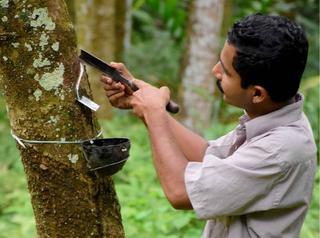VIENTIANE (Vientiane Times/ANN) – Laos’ rubber exports have increased this year even though domestic farmers are still affected by low prices.
 In the first six months of the year, Laos earned almost US$45 million from rubber exports, an increase of 40.8 percent compared to the same period last year.
In the first six months of the year, Laos earned almost US$45 million from rubber exports, an increase of 40.8 percent compared to the same period last year.
The country earned US$40 million from rubber exports in 2013 which rose to almost US$45.2 million in 2014, US$61.2 million in 2015 and US$75 million last year, according to the Ministry of Industry and Commerce.
Local authorities expect exports to increase this year as more rubber trees are tapped. However, most Lao producers are concerned with what they see as the unsustainable low price of rubber as they experience the brunt of oversupply on global markets.
Authorities cannot exert influence on the price of the commodity within the country as most production is for export via foreign traders.
The rubber price in Laos reached a peak of 15,000 kip per kilogram in 2010 but the price paid to growers in northern provinces by Chinese traders has fluctuated between 6,000 and 8,000 kip a kg so far this year.
Unsustainable low rubber prices have caused some growers to abandon the crop in favour of other commodities.
Hundreds of hectares of rubber trees have been cut down to make way for other crops. The government is seeking different measures to help growers such as cooperative marketing and negotiation with neighbouring countries.
The Lao National Rubber Association will be established soon to help protect the interests of rubber growers.
Many growers, especially in the northern provinces, have been struggling with the low world price of rubber and the limited quota of product imported by China.
In the interests of fairness, local authorities have been following the rubber price in China and asking buyers to report the price paid to farmers every week.
The government has ceased granting further concessions for commercial rubber plantations on state-owned land but are allowing local people to grow rubber trees on their land if they wish to.
Laos currently has 275,000 hectares of rubber trees under cultivation including company and local people’s plantations.
The majority of rubber plantation investments in northern provinces are from Chinese companies, while southern parts have seen a number of Vietnamese firms participating.




























